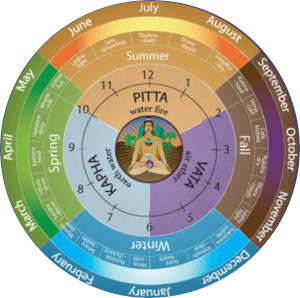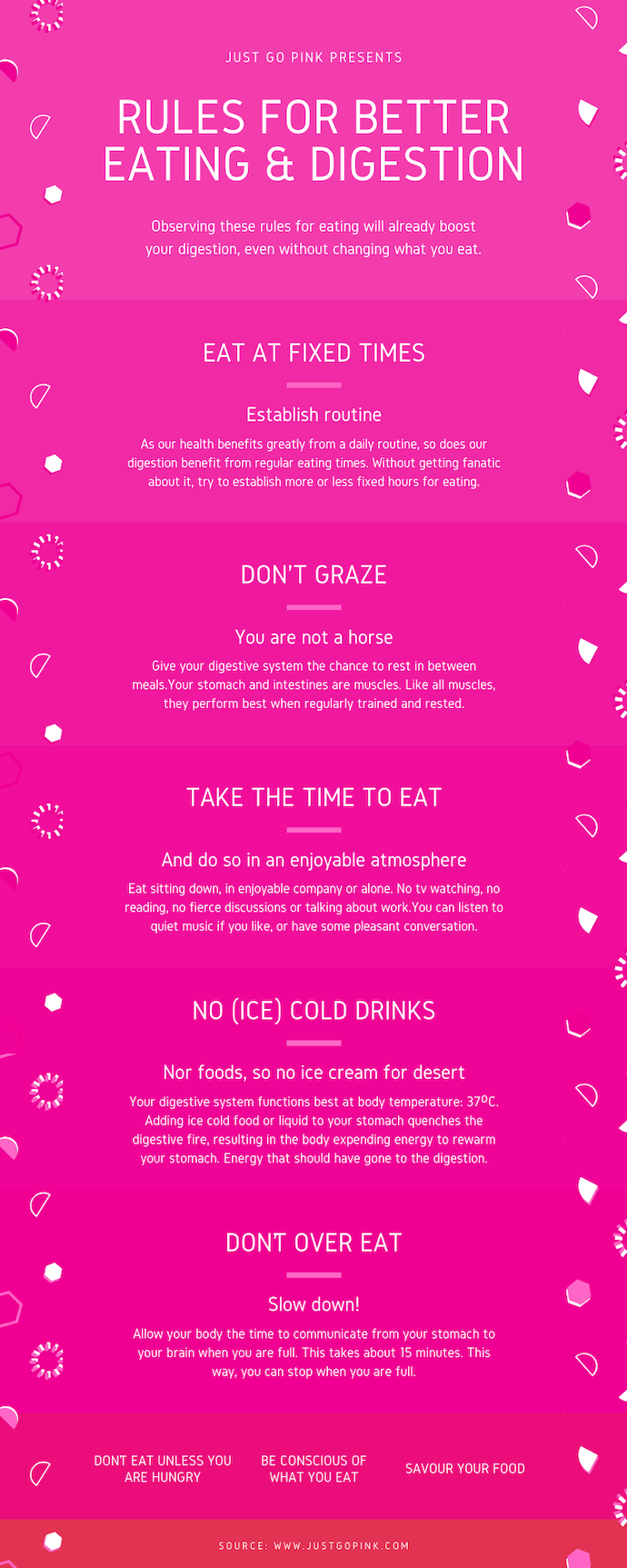Introduction
This Beginner's Guide to Healthier and Happier Living is our take on life and how to live it well. In it, you will find background information about Ayurveda and how we propose to integrate this ancient wisdom into your daily life. We also provide you with examples of how to start making changes to your daily habits. Because we can talk until we are blue in the face, but actually taking that first step is key to any and all change.
We hope this guide will change the way you look at health and happiness, and that it will help you to start the change you want to see in your life. Happy reading!
Namasté,
Karen & Christophe

1) Ayurveda, or “The Science of Life”
Ayurveda is an ancient, holistic system of healing, originating from the Indian subcontinent approximately 5000 years ago. The name is derived from the two Sanskrit words Ayur and Veda, meaning life and knowledge respectively.
Ayurveda thus translates into The Science of Life, and is actually more than a system of healing. It’s more like an instruction manual for healthy living, with a smile and in good spirits

In Ayurveda, prevention is as important as healing. According to Ayurveda, everything and everyone is governed by the three dosha’, these dosha’s can been seen as three energies that manage everything. Every person has a unique “constitution” of the three dosha’s, and when they are in balance, we experience perfect health. Which, by the way, is more than the absence of illness.
“Health is a state of complete mental, social and physical well-being, not merely the absence of disease or infirmity.”
World Health Organization, 1948
This balance is dynamic and under constant strain from the environment. Whereby the environment is everything around us (the air we breathe, sounds, light or lack thereof, smells, etc.), and everything we consume (food, drink, news, social media, etc.). We constantly have to adjust this in order to sustain the balance, very often, we fail to a lesser or greater extent, and we become ill.

Ayurveda vs. Western medicine
We in the west are used to isolating parts of our body that do not function optimally. For example, a person with high blood pressure will be prescribed a drug to lower his or her blood pressure, no questions asked. In contrast, when that person consults a Ayurvedic doctor, it’s a different story.
The Ayurvedic doctor will want to know many things about this person. She/He will search for the cause of the high blood pressure and will certainly ask about eating habits, sports/movement and stress, to name but a few. Once the Ayurvedic doctor has gotten to know the patient, she/he will recommend changes in lifestyle and nutrition, because much quoted Ayurvedic saying is:
“When nutrition is wrong, medicine is of no use. When nutrition is correct, medicine is of no need.”
Ayurvedic saying
Therefore nutrition is the basis of any Ayurvedic treatment.

Three dosha theory
The three dosha theory explains a lot of what Ayurveda is all about. The three dosha's are best seen as energies which are called Vata, Pitta and Kapha and they are involved in virtually everything: seasonal and daily rhythm, life stages, the food we eat, and every living creature, humans included.

Kapha
Kapha represents growth. The elements associated with Kapha are earth and water. The Kapha-dosha characteristics reflect Kapha’s earthy qualities: unctuous, cool, heavy, slow, smooth, soft, and stable. It is also dense, cloudy, and viscous.
In the body these qualities manifest as dense, heavy bones, lustrous, supple skin, low metabolism, and large stocky frames. When out of balance, Kapha individuals are prone to gaining weight and tend to have weaknesses in their lungs and sinuses where there is an accumulation of mucous.

Pitta
Pitta means “that which transforms and digests.” The main element associated with Pitta is fire. This is reflected in the characteristics: hot, sharp, penetrating, and somewhat volatile and oily. The oily nature of Pitta is related to the secondary element of water.
Pitta people tend to feel warm and have somewhat oily skin, penetrating eyes, and sharp features. They tend to have moderate weights and good musculature. When out of balance they tend toward diarrhea, infections, skin rashes and weakness in the liver, spleen, and blood.

Vata
Vata translates as “that which moves things”. The elements associated with Vata are air and space. The characteristics of Vata are dry, rough, light, cold, subtlea and mobile. Vata is often called the “King of the Dosha's,” since it governs the body’s greater life force and gives motion to Pitta and Kapha.
Physically, Vata's tend to be light, their bones thin, and their skin and hair is dry. They often move and speak quickly. When out of balance, they may lose weight, become constipated and have weakness in their immune and nervous systems.



Dosha’s in the phases of life
Life begins with Kapha, or spring. We all begin in the very watery environment of the womb. We establish the solidity of earth known as immunity, this phase lasts until the onset of puberty. The word “Kapha” means to grow and to create form. “Mother’s milk” is the primary substance that nurtures the body and mind and establishes immunity. Kapha governs immunity.
The next phase is Pitta, or summer. Pitta begins with puberty, where testosterone and estrogen further transform the body and mind. Pitta means “that which transforms and digests” and lasts until the years between 45-50. Testosterone is high in men and estrogen is prominent in women, and appetites and metabolism increase. Pitta is about metabolism and governs the endocrine and digestive systems and the sex drive increases. Pitta phase is about establishing and exerting oneself in the world through identity, like the sun wanting to be seen more.
The last stage is Vata, or fall. Vata begins when the processes andropause and menopause initiate. Andropause is the decline of testosterone in men, with an increase in estrogen, and menopause is the decrease of estrogen and an increase in testosterone in women. The poles reverse here, sex drive slows down and appetite diminishes. Vata governs the nervous system and sleep quantity and quality change. This is a more delicate and sensitive time and ends when the last breath is taken.
Vata, pitta and kapha in seasonal and daily rhythm
In Ayurveda, the year is referred to in terms of Kapha, Pitta and Vata season. Kapha season starts mid winter and lasts through the spring. Pitta season starts in late spring and continues through the summer, until early fall. Vata connects the two, so begins in early fall and ends mid winter.
Throughout the day, in blocks of 4 hours, the dosha’s rule. Kapha time is from 6 to 10, Pitta time from 10 to 2, Vata from 2 to 6.
What is "Ayurvedic constitution"?
Understanding your Ayurvedic constitution can help you live healthier and happier.
- Our constitution is the inherent balance of energies within our bodies and our minds.
- It describes who you are on the most fundamental level.
- It defines what is in harmony with our nature and what will cause us to move out of balance and experience sickness and disease.
Because we all have a different balance of energy, Ayurveda shows that the path to optimal health is different for each person depending upon their constitution.
It is characterised by a specific combination of the 3 dosha's, which are specific to each person. Ayurveda defines disease as the natural end result of living out of harmony with one’s constitution.
So understanding your constitution and how it interacts with your environment is key to good health. And since we all have a unique constitution, what is good for one person may be bad for another, and vice versa.
2) Ayurveda and Yoga
Yoga and Ayurveda are two therapeutic disciplines that both originated in India. They are sister sciences that have many parallels and they complement each other. Ayurveda and Yoga are derived from the "Vedas" which is a set of texts with very ancient knowledge on very diverse subjects.
Ayurveda means the science of life and Yoga means union, binding together. The goal of both systems is a healthy and happy life, but in order to use them well, we must at the same time learn to know ourselves and accept ourselves as individuals.
900 years ago, Hildegard of Bingen said that good health does not only mean not being ill, but on the contrary, having energy in the body and of course a good moral balance. This definition is very similar to the philosophy of Ayurveda and Yoga, a state of expansive forces that allows us to live our daily lives with enthusiasm and with the serenity that comes from a calm mind.
Ayurveda
Ayurveda provides tools that can help a person find a harmonious connection with oneself and ones environment.
Yoga and Ayurveda both have their unique place and function, but they also overlap at several levels. They are therefore considered sister practices and are known for their healing benefits. Simply put, Yoga aims to harmonize mind, body and soul while Ayurveda takes care of the health of the person, both mental and physical. So, these two practices complement each other very well and are deeply interconnected.
Harmony between body and mind
Ayurveda is also geared towards harmony between body and mind, and this science offers many benefits, such as reducing stress, eliminating toxins and improving circulation... The first research into Ayurveda was done in India thousands of years ago and it is probably the oldest medical system in the world. In India, there are Ayurvedic universities and doctors, hospitals and pharmacies.
Ayurveda was developed to diagnose imbalances in the body-mind combination that manifest themselves as diseases or other symptoms. The aim is to restore balance in this mind-body combination through a life adapted to the individual by using products of nature, deep massage and other forms of therapy. Ayurveda as a holistic medical system is a system of prevention as well as healing.
Yoga
Yoga is not a medical system in origin or in itself and does not primarily deal with physical or psychological illnesses or their treatment. Yoga is an external physical, and at the same time internal spiritual practice. Like Ayurveda, it’s a system of prevention as well as healing.
Yoga aims, by using our body, to relieve psychological suffering, which it defines as ignorance of our true nature as pure consciousness, that leads us to a false identification of ourselves with our body and mind. A definition of Patanjali's Yoga (Editor of Yoga Sūtra, the classical guide to Yoga) "Yogas chitta vritti nirodha", which means the elimination of fluctuations of the mind through yoga, which is also the goal of meditation. We see that all systems help each other in servicing the human being.
This does not mean that we cannot use certain aspects of Yoga medically, but that is not its primary intention or orientation. In physiotherapy, for example, there are a lot of exercises that originate from Yoga. Different Yoga poses have different effects on a person's body and help to maintain the balance between the three dosha’s (the vital energies of Ayurveda responsible for physiological and psychological processes).
Yoga and the dosha’s
Forward bending Yoga postures help to cool the Pitta of the body. Yoga postures involving twisting are considered useful for Kapha as they stimulate the digestive fire. Yoga postures involving backward bending warm the body and thus balance Vata. Yoga postures are known to tone every area of the body and also help to get rid of toxins, which is also a major goal of Ayurveda.
Benefits of Yoga
If you search on the Internet for "benefits of Yoga", you will find literally dozens of them. Let's limit the list to those that have been scientifically researched and confirmed. Yoga:
- reduces stress;
- relieves anxiety;
- reduces inflammation;
- improves heart health;
- improves quality of life;
- fights depression;
- reduces chronic pain;
- promotes sleep quality;
- improves flexibility and balance;
- helps to improve breathing;
- relieves migraines;
- encourages healthy eating habits;
- increases strength;
- puts you in a good mood.
Add to this the fact that you can do Yoga in the privacy of your own home without the need for any special equipment, except for a Yoga mat. What's more, these days you can learn from online teachers.
But beware: that is not for beginners!
A visit to a Yoga studio is a must to learn the basics and avoid injuries. Yoga is a sport like any other, although many men condescendingly refer to it as an activity for women only ????
It has the advantage later on that you don't necessarily have to leave your home to attend a yoga class at a specific time, but to do it at any time of the day, according to your schedule.
The important thing about Yoga is never to exceed the threshold of pain or allow your ego the upper hand, or wishing to do as the teacher does or more advanced students. Don’t forget they have been practicing for years and you are only just beginning.
There are dozens of forms of Yoga and each teacher has his or her own style. So, if you decide to start with Yoga, look around, try different classes and different forms of Yoga. You need to have a good spiritual connection with the teacher. If you don't enjoy the class, try another form, otherwise you won't get any benefit. The important thing in a yoga session is to combine the position, breath and calmness of mind. You cannot learn this in a few hours and some practice and routine is necessary.
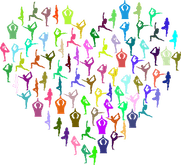
Most common styles of Yoga
- Hatha Yoga
- Very good for beginners who want to learn yoga from scratch. My recommendation!
- Sivananda Yoga
- Sivananda Yoga is basically Hatha Yoga with a meditative side to it. It consists of a series of postures, always the same, which make doing them at home easier without always having to visit a class.
- Iyengar Yoga
- Hatha Yoga is also the basis here. It requires the use of supports (blocks, straps, chairs, blankets, etc.) for very exact postures that are held very long.
- Acroyoga
- A mixture of Yoga and acrobatics. For very advanced and sporty students.
- Aerial Yoga or Fly Yoga
- Developed by physiotherapists, it is a mixture of Yoga, meditation and fitness, all of which is situated above the ground, hanging in a special, hammock-shaped sling. Very pleasant and positive for people with physical difficulties.
- Ashtanga / Vinyasa Yoga / Vinyasa Flow / Power Yoga
- These are fluid and dynamic styles of Yoga where the postures are chained together. Basically, also Hatha (Iyengar) Yoga and most suitable for students who are a bit sporty and need some action.
- Bikram or Hot Yoga
- Postures practiced in rooms of around 40°C. Controversial because not suitable for everyone, for example Pitta people. Here too the basis is Hatha Yoga.
- Jivamukti Yoga
- With a true philosophy of life, based among other things on deep breathing, music and singing. Inspired by Ashtanga and Vinyasa Yoga.
- Kundalini Yoga
- It is above all a contact with oneself and ones own consciousness. It allows us to get to know ourselves better intuitively rather than intellectually.
- Yin Yoga
- A meditative Yoga represented by immobility with a gentle practice to release pressure. The opposite of Yang Yoga (Hatha Yoga) representing movement and strength.
Derivatives of Yoga
If the Yoga styles mentioned are not suitable for you or you can't find any in your area, there are alternatives, but these too are partly based on Hatha Yoga.
Pilates
Pilates is a fitness system developed in the early 20th century by Joseph Pilates, who gave it its name. Pilates called his method "Contrology". It developed as a result of the physical fitness of the late 19th century, which consisted of exercising to alleviate health problems.
His basic training methods date back to Yoga and Zen meditation, which he studied closely. Studies show that while Pilates improves balance, it has not proven to be an effective treatment for any disease, other than proof that regular Pilates sessions can help muscle conditioning in healthy adults, as opposed to not exercising at all.
Being German, Joseph Pilates was interned at the beginning of the First World War in England and his fellow inmates who followed his method survived the great flu pandemic of 1918 thanks to their good physical condition!

Modern Yoga, like Pilates, is a discipline of the mind and body, although Yoga classes are more likely to explicitly address spiritual aspects. Some poses are similar in both disciplines; for example, the open leg balance is very similar to the Navasana, the boat pose; the inversion is similar to the Halasana, the plough pose; and the swan and push-up are essentially the same as the Bhujangasana, the cobra pose and the Chaturanga Dandasana, the low board pose, respectively. Both disciplines develop strength, flexibility and fitness. Pilates, however, emphasizes core strength, while Yoga emphasizes flexibility.
Callanetics
This exercise program was developed in the early 1980s by Callan Pinckney. She developed it from classical ballet and Yoga exercises to help relieve a back problem she was born with.
The theory of callanetic gymnastics is that the surface muscles of the body are supported by deeper muscles, but popular exercise programs often exercise only the surface muscles. According to callanetic gymnastics, the deeper muscles are best exercised using small but precise movements. Deep muscle exercise also improves posture, which can make it look like you're losing weight, even if you've lost very little weight.
Synthesis
Let's not forget that from the age of 40 onwards, both muscle mass and coordination decrease without any specific countermeasure. So, it is never too late to start getting in good physical condition. This in turn increases moral satisfaction.
"Mens sana in corpore sano", which means "A healthy mind in a healthy body", was already written by Juvenal, a Roman satirical poet of the late first century. A healthy body also needs a healthy mind.
A short parenthesis on jogging...
If you enjoy jogging, don't forget to first warm your body up with a few minutes of brisk walking. Especially after jogging do some stretches or yoga postures to keep your muscles lean.
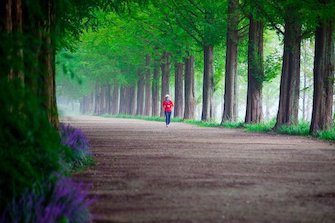
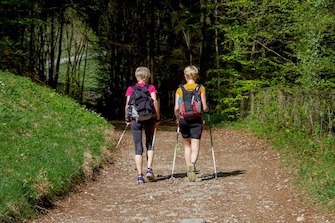
Tip: brisk walking is a great alternative to jogging and a good supplement to yoga sessions, especially for those with knee or hip problems.
It's an ideal exercise because your hips, knees and ankles don’t take the shock of impact with each step and you can walk longer distances, which is very beneficial to prevent cardiovascular risks! It's gentle on the joints, so it's easily accessible.
Practiced regularly and dynamically, it tones the muscles of the lower body, especially the thighs and buttocks. It also burns calories and at the end of the session, you feel good, but not exhausted like after a jog.
A new fashion, "Nordic Walking" offers a very good combination using the arms. It is at least 50% more efficient than walking without sticks and with Nordic Walking, you use more than 80% of your muscles.
3) Breathing
Breathing plays one of the most important roles in our lives. Let's not forget that...
- without food we can theoretically survive between 30 and 80 days, depending on our personal constitution and on one condition only: drinking water.
- without water, life expectancy drops to approximately three days.
- without breathing, on the other hand, we only have a few minutes left!
The extraordinary thing is that our breathing works automatically most of the time... as do all the processes in our body.

Our heart beats continuously, without us being aware of it, about 100,000 times a day and 36.8 million times over a year, without ever taking a break (fortunately! ????). The heart pumps blood and circulates it through the network of arteries and veins in the lungs.
- The arteries distribute oxygen-enriched blood through the lungs to the rest of the body.
- The veins carry oxygen-depleted but carbon dioxide-rich blood back to the lungs.
- There's a very direct connection between our lungs and our heart. No organ can perform its functions without being supplied with oxygen.
- Over the course of a lifetime, the lungs will receive 300 million liters of air.
- That means that about 12,000 litres of air per day circulates through the lungs.
The respiratory system and your emotions
What's the use of emotions? Emotions ensure our survival and allow us to communicate and adapt to the stages of life.
Different research shows that there is a direct connection between our breathing and our emotions. This synchronization goes both ways. When we are disturbed, we get carried away by our emotions, and our breathing changes. On the other hand, doing breathing exercises can reduce stress, pain and anxiety.
Speakers, singers, swimmers and runners know it well: controlling our breathing is essential to accomplish certain tasks. Try to breathe out slowly and regularly, and you will be amazed at how your inhalation, and therefore your breathing in general, will improve.
Most of us are "half-breathers". We breathe because we can't help it, but we don't breathe out completely. True breathing control means that you must first learn to breathe in well, and then of course also to breathe out well, that is, all the way into your abdomen.
Your breath is your closest friend, It is the essential link between your body and your mind. Also your breathing reacts to and influences your emotions and thoughts.
Each of us has certainly experienced a difficult situation where we have used a deep breath in order to calm down. So you understand the importance role breathing plays in your well-being.
The importance of good breathing
Without paying attention to our breathing, over time, we easily develop bad habits. Without being aware of ourselves in the present moment, these bad habits will, in the long run, disturb our entire system. Because a good supply of oxygen in the blood facilitates the good functioning of our organs and therefore If our blood lacks oxygen, our organs are in danger.
When we are engaged in sports, when we are experiencing an intense emotion or an exceptional situation, we sometimes pay more attention to our breathing. In those moments, we use it consciously or unconsciously so that our body is well supplied with oxygen. In this way, most of the time, we recover our mental balance.
In Eastern cultures Shaolin monks, Kung Fu or Qi Gong masters (pronounced "Tchi Kung", gymnastics based on breath control) for example use Chi (Energy of Life, Prana in Ayurveda). An immense force generated through breathing techniques.
One of the goals of our life is to be happy, in harmony with ourselves and our surroundings. Try as often as possible to be conscious of what is happening around you, but especially within you... including all your thoughts and feelings.
- What are the thoughts that haunt you the most? And which you would like to eliminate?
- How do you react to external stimuli?
- What happens to your emotions and how do they affect your breathing?
We will discuss answers and practices to make your breathing a tool that will help you to (re)find calm and balance in your daily life in the next chapter.

4) Meditation
When I listen to what most of my interlocutors tell me about meditation, I realize that the general public has the wrong idea of what meditation actually is and like any convictions, it’s difficult to change or get rid of it.
Meditation is not the total and complete absence of all thoughts, rather it's to find a balance and to be in harmony with your current activity, being here in the present moment and doing only one thing at a time... Which for most of us is very difficult!
Being in flow
There are many situations where you are in a state in which nothing else is important, perhaps listening to your favourite music for example, playing a musical instrument, sitting by the water, on top of a mountain or gardening. You loose yourself in something that you love doing and you automatically flow into a meditative state. Time stands still, an hour passes and feels like only a couple of minutes. This is what happens to children who are immersed in their own little world.
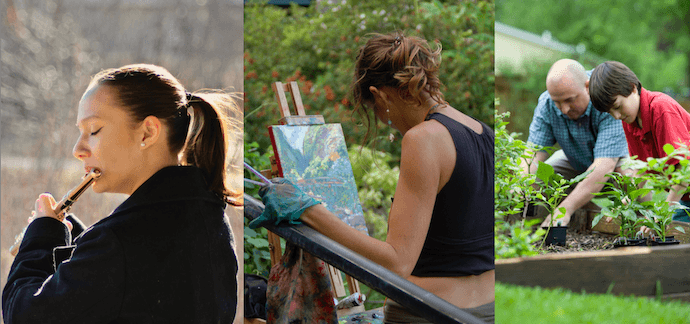
You see, you can easily be in the here and now because you have already unconsciously practised it many times in your life. Meditation neither means to withdraw into yourself and forget about the rest of the world, It simply means to be in the present moment with an activity done with passion. In meditation you recover the strength and calm necessary to live a healthy and balanced life in this very hectic world of ours.
You can also meditate passively but consciously, sitting or lying down paying attention to your breathing and ignoring as much as possible what is going on around you. Partly emptying yourself, yes, but the total absence of thoughts will not last very long, which is normal. Contemplation on an object, a photo or a landscape is also a form of meditation.
Meditation techniques
There are hundreds of meditation techniques. Guided or in silence, with Mantra and/or with breathing...etc.
The best known, to name only a few, are very sophisticated like, transcendental meditation or TM (a relaxation technique) and Vipassana (an ancient Buddhist system of training the mind, with exercises that are often meticulous and a little difficult at first). Zen, which means meditation, requires full attention/consciousness on the present moment, often facing a wall, and staring at it.
They all have a different approach, but their goals are very similar: to control the flow of our thoughts and find inner peace.
Leave your ego at the door
Your ego, which is the sum of your personality, always wants to direct all operations. When you meditate, you try to get out of its influence and calm your mind which always wants to solve problems.
However, most of the time it just creates new ones, because one thought generates another and the next, etc. You end up going round and round in circles, repeating the same thing to yourself or to others, for as long as there are no answers or solutions.

“Meditation is the elimination of the fluctuations of the mind, thus bringing calm and harmony to our thoughts. And you can start meditation at any age.”
The programs offered by Just Go Pink! present solutions and simple exercises to integrate into your daily life. In the long run, without effort and even realising it, they will change your way of being present in the moment and how you interact with your surroundings.
For example:
- Learning to listen to what others are saying without interrupting them because you loose yourself in your own thoughts before the other person has even finished speaking.
- Developing positive thoughts and compassion for yourself and others.
- Finishing one task before starting another.
- Realising that the present moment is unique and will never return, so it is very precious.
- And thus that, each argument is ultimately a waste of energy and that it is often better to give in, in order to have a pleasant journey.

5) Nutrition
Hippocrates said it four centuries BC:
“Let food be thy medicine and medicine be thy food.”
Hippocrates
Ayurveda puts it like this: when diet is wrong, medicine is of no use; when diet is correct, medicine is of no need. What it boils down to is this: you literally are what you eat.
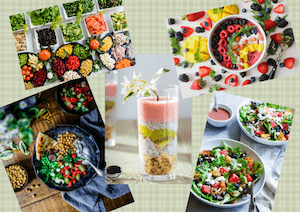
Every cell in your body renews with a certain frequency, from every couple of weeks (skin) to every 10 years (bone). Each cell is built with building blocks derived from what food you eat. Therefore, our food is of paramount importance to our health.
Now that we have clarified that, the question that arises is: what is healthy food? Commercially, we are bombarded with ads for “healthy” products. Unfortunately, as a rule of thumb, you can say that anything that is advertised is not healthy. Why? Because it is processed. Unprocessed food is rarely advertised…
So part of the answer is: unprocessed food is healthy, processed food isn’t. The other part of the answer is: it depends on your constitution and your circumstances. If you are a Kapha dominant person, or your Kapha is aggravated, you benefit from (for example) beans. Eating dishes with beans on a daily bases would be good for you. On the other hand, if you are a Vata dominant person, or your Vata is out of whack, you should avoid eating beans, this is just one example.
Equal but not the same
In our western way of looking at things, we always try to define foods as good or bad for everyone. As if we are all the same, but we’re not. Equal yes, but identical no. And then again, there are seasonal influences, and the time of day, the place where you eat and many more factors that play into it. Getting confused now? Sorry about that…
There’s also a growing tendency to eat out. Which unfortunately means in most cases that we eat less healthily. You will even hear people talking about “grabbing something to eat”. Or even “eating while on the go”. All this hurrying and multi-tasking is not good for your health! Always remember:
“If you don't take time for your wellness, you will be forced to take time for your illness.”
Joyce Sunada (wellness coach)
So instead of buying fast food, prepare slow food. Using real ingredients from clean sources. Gradually rearrange your schedule and make time to take care of yourself and your body. It’s the only one you have in this life, and you will thank yourself later.
Where do you start? Well, you could start with the habits you currently have around eating. Not with what you eat, but the circumstances. In order to take advantage of your food, you need to be able to digest it. And there are many factors that influence our digestive fire (called Agni in Ayurveda), apart from the food itself.
Rules for better eating and digesting according to Ayurveda
Observing these rules for eating will already boost your digestion, even without changing what you eat:
6) Taking Care of the Environment means Taking Care of Ourselves
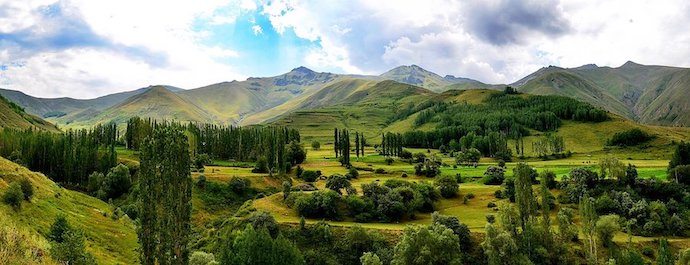
As a species, we have lost touch with nature. We have set ourselves apart and above it, denying that we are an intricate part of it. Especially that we depend on it.
We use our environment as if it could sustain us into eternity. Which it cannot, because all natural resources are limited. We think only of ourselves without a second thought for the consequences of our actions. Which is strange, because we all need clean air to breath and clean water to drink. If we continue the way we have for the last decades, we will poison our environment to the extent where everybody is affected.
As a consumer, you may feel powerless to change anything, but you aren’t. Because in the end, we as consumers direct what is produced and how it is produced, we do this by choosing what we consume. As long as we buy goods that harm our environment and cause suffering to other beings, manufacturers and producers will continue as they are. But when we take responsibility for our part in the chain, we can be part of the change.
Many people argue that my single actions as one person have no consequences whatsoever. That is not true, because if everybody did it, change would be instantaneous. Someone has to start the change, so it might as well be you.
We should always examine our behaviour:
- What are we buying and where?
- What do we throw away? And in what quantities?
- What can we do to make things better?
Eat less meat
It takes 7 kg of grain to produce 1 kg of beef. And between 5.000 and 20.000 litres of water. For an example: producing 100 grams of protein from peas emits only 0.4 kilograms of carbon dioxide equivalents (CO2). To obtain the same amount of protein from beef, emissions are almost 90 times higher, equivaling about 35 kg (CO2). So reducing your meat consumption has a significant effect on the environment. You give the example, explain the rationale without preaching, and others will follow.

Refuse single use plastics
Try to bring your own shopping bags when you go shopping. Also for vegetables and fruits. Small, washable and reusable organic cotton bags are available almost everywhere, or you can make your own. If possible, buy fruits and vegetables at a farmers' market instead of pre-packaged from the supermarket. The produce is fresher and there is less transport involved, which is also better for the environment. Avoid buying bottled water, and if possible, install a filter at home. And if you must buy bottled water, buy it in the largest bottles you can find.

Research cosmetic products
Cosmetic products like shampoo, body lotion and make up are usually produced using ingredients that are both harmful to the environment and to your skin. Additionally, they are tested for safety in laboratories, using animals who greatly suffer in the process. This is no longer necessary, as there are now alternatives that do not harm the environment nor your skin, and are tested without using animals. Search for and buy eco-friendly, cruelty free and plant-based cosmetics. They may be more expensive, but they are better for your body and the environment.

Consume less but better quality
We live in a world where we consume without being conscious of it. We “go shopping”, meaning we go into the city, look at everything that’s on offer, and buy whatever takes our fancy. Temptations are everywhere and buying makes you forget your frustrations for a few moments.
Many of us have closets bursting with clothes and shoes and other stuff, and yet we continue to buy. Why? Just because we can…? Well, it’s time to reconsider. What is most important in life? Health and happiness, right? So do you really need all this stuff for that?

Imagine for a moment that you have no credit card and very little money to spend. What would you buy? Is there anything material wise that you really lack? And for those of you who buy on credit: what would it feel like if you were free of debt? Just think about that next time you feel like going shopping.
The same is true for shopping online. Or maybe even more so, because that comes with added packaging and transportation.
These are just a couple of examples to help you on your way. But there are plenty of things you can do to reduce your negative impact on the earth, which doesn’t have to leave you feeling deprived of anything. Becoming conscious of what you really need to be healthy and happy can actually be quite fun and liberating!
7) Taking Small Steps is the Key to Changing your Habits for Good
Whatever you do, don’t make a big deal out of it. It is far better to regularly make small changes that you can stick to, rather than to try and change everything overnight.
You see, we are evolutionary hard wired to resist change. So any thought of big changes will get the left hand side of your brain in a panic, screaming NO and hitting the brakes. In order to circumvent this from happening, you have to make little changes. Make them so small that they seem insignificant. This will put the left hand side of your brain to sleep and that’s when the magic can take place.
Most if not all of us have habits that we would like to change. Whether it is changing our diet, working out (more), taking the stairs instead of the elevator, or cycling instead of taking the car, being more mindful, journalling, being more grateful… We all have something. Otherwise, you wouldn’t be reading this text.
Where to start?
It’s up to you to decide where you want to start. And frankly, it doesn’t matter where you start. Not really. Because anything changed for the better is good. Having said that, here’s what we recommend you to do:
- 1Take stock of your life and your habits. Imagine what your life would look like if you had changed all the habits you would like to change. Make a list.
- 2For each one, break down the change into little steps that you feel you could do. For example: if you want to become a vegetarian, the first step would be to eat vegetarian one day per week. Once you are used to that, introduce a second vegetarian day. And so on, until you have reached your goal. This may and probably will take several months, and that is just fine.
- 3Meanwhile, there are other habits you want to change, so while you are getting used to eating vegetarian once a week, you can tackle another habit. For example reduce your daily coffee consumption by one cup.
- 4Don’t be hard on yourself if one day, you don’t stick to the new program. Show yourself compassion. It doesn’t mean that you are a complete failure, it just means you failed once. Pick yourself up, smile, and continue. Do not use this once-in-a-while mishap as an excuse to quit!
- 5In this way, you make a small change every week. One week it has to do with your eating habit, the next it has to do with moving more, another week you start a mindfulness practice, after a couple of weeks you up the scale on changing your eating habit, etc.
This way, you progress on all counts without any of them seeming like a big deal. But in the end, you will have made some mayor changes to your life style. And that’s what this is all about: taking matters into your own hands. Empowering yourself and becoming the best version of yourself. Living a healthy and happy life into a ripe old age.
What’s next?
Most of all, we encourage you to just start. Pick something, decide how you want to change it and take a first step. And if you need help, we are there for you. Just head over to our blog where you will find inspirational articles and courses on Ayurveda, nutrition, yoga, meditation, etc.
Let us know how we can help you further on your journey towards a healthier and happier life.
Sources
Websites:
Tridosha: The Science Of Ayurveda and the three doshas (vata, pitta, kapha)
Three phases of life, according to Ayurveda
Ayurveda 101
Less meat is nearly always better than sustainable meat, to reduce your carbon footprint
Books:
Prakriti: your Ayurvedic constitution by Robert E. Svoboda

